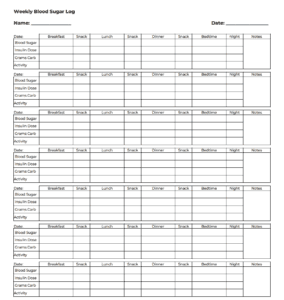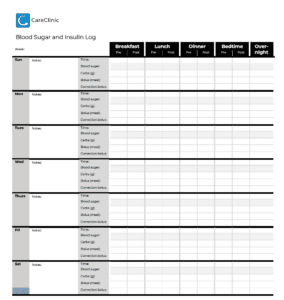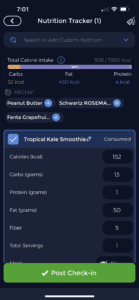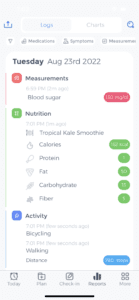 Printable blood sugar logs are an important part of tracking and managing diabetes, but they can be difficult to keep up with. The CareClinic App makes it easy to track your blood sugar levels and see patterns over time. Simply enter your readings into the app and it will generate a printable log that you can take with you to your doctor’s appointments. You can also set reminders and goals to help you stay on track. Let’s learn more about how to make use of the logs and what type of values you should expect to write in them and when to actually record your values.
Printable blood sugar logs are an important part of tracking and managing diabetes, but they can be difficult to keep up with. The CareClinic App makes it easy to track your blood sugar levels and see patterns over time. Simply enter your readings into the app and it will generate a printable log that you can take with you to your doctor’s appointments. You can also set reminders and goals to help you stay on track. Let’s learn more about how to make use of the logs and what type of values you should expect to write in them and when to actually record your values.
Table of Contents
- Getting diagnosed with Diabetes
- What are the effects of Diabetes type 1 and type 2?
- What are some diabetes complications?
- What is the outlook for people with diabetes?
- Create a Diabetes Care Plan
- What is a printable blood sugar log?
- The benefits of tracking your blood sugar levels
- Tips for tracking your blood sugar levels effectively
- How to use a printed blood sugar log sheet
- Free Printable Blood Sugar Log Sheets & Glucose Worksheet in PDF
- Blood Glucose Charts
- Tracking Blood Glucose level using a Mobile App
- Pre-testing tips for correctly measuring blood glucose
- Post-testing care
- Successful Diabetes Management
Getting diagnosed with Diabetes
There are a few symptoms of diabetes, such as:
- Urinating often
- Feeling very thirsty
- Feeling very hungry – even though you are eating
- Extreme fatigue
- Blurry vision
- Cuts/bruises that are slow to heal
- Weight loss – even though you are eating more (type 1)
Type 1 Diabetes
Type 1 diabetes is when your body does not produce insulin. Insulin is a hormone that helps your body convert sugar (glucose) into energy. without insulin, too much sugar stays in your blood. There is no known way to prevent type 1 diabetes. It is usually diagnosed in children and young adults. Treatment for type 1 diabetes includes taking insulin shots or using an insulin pump. You will also need to follow a healthy eating plan and exercise program.
Type 2 Diabetes
Type 2 diabetes is when your body does not use insulin properly. Insulin is a hormone that helps your body convert sugar (glucose) into energy. Without insulin, too much sugar stays in your blood. Type 2 diabetes is the most common type of diabetes. It is usually diagnosed in adults over the age of 45. However, it is now being diagnosed in children and young adults more often than in the past. This may be because people are overweight and not as active as they should be.
Treatment for type 2 diabetes includes taking insulin shots or using an insulin pump. You will also need to follow a healthy eating plan and exercise program. If you are overweight, your doctor may recommend that you lose weight. Losing weight can help you control your blood sugar levels better.
Gestational Diabetes
Gestational diabetes is when you have high blood sugar levels during pregnancy. It usually goes away after the baby is born. However, if you have gestational diabetes, you are more likely to develop type 2 diabetes later in life. Treatment for gestational diabetes includes following a healthy eating plan and exercising regularly. You may also need to take insulin shots or use an insulin pump.
Pre-Diabetes
Pre-diabetes is when your blood sugar levels are higher than normal but not high enough to be diagnosed as type 2 diabetes. If you have pre-diabetes, you are at risk for developing type 2 diabetes.
Treatment for pre-diabetes includes following a healthy eating plan and exercising regularly. Losing weight can also help you control your blood sugar levels better. If you have any of these types of diabetes, it is important to see your doctor for treatment. Early diagnosis and treatment can help prevent complications from diabetes.
What are the effects of Diabetes type 1 and type 2?
Both type 1 and type 2 diabetes mellitus are chronic diseases that can have serious complications. People with diabetes mellitus have an increased risk of developing cardiovascular disease, kidney disease, and nerve damage. Diabetes mellitus is also a leading cause of blindness and amputations. According to the Centers for Disease Control and Prevention (CDC), about one in every four deaths in the United States is caused by diabetes mellitus.
Type 1 diabetes mellitus, also known as insulin-dependent diabetes, is a chronic disease that affects children and adults. People with type 1 diabetes mellitus need to take insulin injections to control their blood sugar levels. Type 2 diabetes mellitus, also known as non-insulin-dependent diabetes, is a chronic disease that usually affects adults.
People with type 2 diabetes mellitus can control their blood sugar levels with diet and exercise. However, some people with type 2 diabetes mellitus may need to take insulin injections to control their blood sugar levels.
Both type 1 and type 2 diabetes mellitus are serious diseases that can lead to complications if not properly managed. People with diabetes mellitus should work with their healthcare team to create a treatment plan that includes healthy eating, regular physical activity, and blood sugar monitoring. (“Complications.” Centers for Disease Control and Prevention. Centers for Disease Control and Prevention, 1 Mar. 2018.)
What are some diabetes complications?
Diabetes can cause many complications. These include heart disease, stroke, kidney disease, nerve damage, and vision problems.
Heart Disease
If you have diabetes, you are at risk of developing heart disease. Heart disease is the leading cause of death in people with diabetes. To help prevent heart disease, you should manage your blood sugar, blood pressure, quit smoking if you smoke, and manage your cholesterol levels.
Stroke
If you have diabetes, you are at risk for having a stroke. A stroke occurs when the blood supply to your brain is cut off. This can happen if a blood vessel in your brain bursts or is blocked by a clot.
Kidney Disease
Kidney disease can lead to kidney failure. This is when your kidneys stop working and you need dialysis or a kidney transplant.
Nerve Damage
Nerve damage can cause problems with your hands and feet. You may have trouble feeling pain, heat, or cold. You may also have problems digesting food.
Vision Problems
Vision problems can include cataracts, glaucoma, and retinopathy. Retinopathy is when the blood vessels in your retina are damaged.
What is the outlook for people with diabetes?
The outlook for people with diabetes has improved over the past few years. This is due to better treatments and more awareness of the disease. However, diabetes is still a serious disease. It can lead to heart disease, stroke, kidney disease, nerve damage, and vision problems. People with diabetes need to see their doctor regularly. They also need to control their blood sugar levels and take steps to prevent complications.
Create a Diabetes Care Plan
1. Schedule an appointment with your primary care physician to establish a diabetes care plan.
2. Meet with a registered dietitian to develop a healthy eating plan.
3. Begin a moderate exercise program as recommended by your physician.
4. Check your blood sugar levels regularly and record the results in the CareClinic App regularly or a printable blood sugar log
5. Report any changes in your blood sugar levels or health to your physician immediately.
6. Follow up with your physician and dietitian as recommended to monitor your diabetes care plan.
What is a printable blood sugar log?
A blood sugar log is a way to track your blood sugar levels over time. This can be done with an app or by printing out a log sheet. Tracking your blood sugar levels can help you manage your diabetes and avoid complications. There are many different ways to track your blood sugar levels. You can use an app, print out a log sheet, or even keep a notebook. Whichever method you choose, make sure to track your blood sugar levels every day. This will help you see trends and make changes to your diet or exercise routine if needed.
Types of printable blood sugar logs
There are a few different types of blood sugar logs all of which that we allow you to print, such as the weekly blood sugar log, insulin log, monthly blood sugar logs, weekly blood sugar pattern worksheets, detailed 3-day diabetes charts, diabetes insulin pump record for insulin pump users.
The benefits of tracking your blood sugar levels
1. You can see how your blood sugar levels change over time.
2. You can spot trends in your blood sugar levels.
3. You can learn what triggers high or low blood sugar levels.
4. You can make changes to your diet or exercise routine based on your blood sugar levels.
Tips for tracking your blood sugar levels effectively
Your doctor wants you to track your blood sugar levels because it can help you manage your diabetes. When you track your blood sugar levels, you can see how different foods, drinks, and activities affect your blood sugar. This information can help you make changes to your diet or exercise routine. It can also help you spot trends in your blood sugar levels.
If you see that your blood sugar is consistently high after eating certain foods, you can make changes to your diet. If you see that your blood sugar is low after exercising, you can make sure to exercise more often. Tracking your blood sugar levels can help you manage your diabetes and avoid complications.
How to use a printed blood sugar log sheet
If you’re tracking your blood sugar levels with a printed log sheet, you’ll need to fill out the sheet every day. Make sure to include the date, time, and your blood sugar level for each entry. You can also include other information like what you ate that day or if you exercised. The date and time are important so you can track your sugar levels over time. The blood sugar level is obviously the most important part of the reading! This is the number that tells you how high or low your blood sugar levels are. If you used a printable blood sugar log make sure you keep track of your levels, many apps will automatically let you know if you are within range.
What is an average blood sugar level?
A normal blood sugar level is between 70-140 mg/dL. However, this number can vary depending on the time of day and what you’ve eaten.
What is a high blood sugar level?
A high blood sugar level is anything above 140 mg/dL. High blood sugar levels can be dangerous and should be treated immediately.
What is a low blood sugar level?
A low blood sugar level is anything below 70 mg/dL. Low blood sugar levels can be dangerous and should be treated immediately.
Free Printable Blood Sugar Log Sheets & Glucose Worksheet in PDF
The glucose worksheet is a handy tool to help you understand how your diet affects your blood sugar levels. Use these printable sheets to manage your blood glucose levels. You can take blood sugar readings using a glucometer (blood sugar meter), which can be bought at most pharmacies or you can get a modern one from here. The blood sugar log sheet has spaces to record fasting, before-meal, and bedtime readings. There is also a section to note the foods you ate and any insulin dose or medication you took.
 |
 |
 |
⬇️ Weekly Printable Blood Sugar Log PDF |
⬇️ Monthly Blood Sugar Log PDF |
⬇️ Blood Sugar and Insulin Log PDF |
 Easily log Blood Sugar Values |
 Save and check off nutrition |
 View Logs of your progress on the go! |
? Try Blood sugar log App |
? Try Diabetes Logbook App |
? Install Blood Sugar App |
Blood Glucose Charts
A blood glucose chart is the same as a fasting blood sugar chart. This shows your blood sugar levels before and after you fast, which can help you to see how well your body can regulate blood sugar when you’re not eating. See the normal, fasting and after-eating levels below:
Target Range
Fasting: 80-100 mg/dL (Official ADA recommendation is 80-130 mg/dl or 4.4-7.2 mmol/L)
After eating: below 170-200 mg/dL
2 hours after eating (Postprandial): below 120-140 mg/DL, generally < 140 or 7.8 mmol/L (ADA: < 180 mg/dl or 10.0 mmol/L)
HBA1C: Less than 5.7% (ADA recommendation: 7.0% or less)
Tracking Blood Glucose level using a Mobile App
It is a modern solution and works better because you don’t have to carry a printed log sheet with you everywhere. You may also use both a printable blood sugar log and a digital app together if you wish. An app like CareClinic can help track your blood sugar levels on your phone. CareClinic has a food database with over 300,000 foods, so you can easily track the carbs consumed by the time of day or meal type along with other macronutrient information.
You can integrate the app with your fitness tracker to track your activity levels, too. The app works with Apple Health and Google Fit to bring all your data together into one central place without needing multiple Apps! Simply connect your blood glucose meter to Apple Health and allow CareClinic to read your values automatically.
You can also set reminders to take your medication or insulin. The app is free to download and use for Diabetes, and it’s available for iOS and Android devices. The data can be shared either remotely and digitally from within the App using the Care Team module or you may export your data as a CSV file (for Microsoft Excel) or PDF and print it to share with your doctor. To get started using CareClinic tap here.
Terms in the logs (FAQ’s)
- Bolus and correction bolus refers to insulin doses given to lower high blood sugar levels.
- Basal refers to the background insulin that is always released to keep blood sugar levels steady.
- A carbohydrate-to-insulin ratio is the number of carbohydrates that one unit of rapid-acting insulin will cover.
- A blood sugar target is the blood sugar level that you are aiming for.
- Insulin sensitivity factor is the amount that one unit of insulin will lower your blood sugar levels. Correction factor means the same thing. If you have any questions about the terms used in these printables, please speak to your healthcare team.
- Multiple daily injection therapy is when you give yourself two or more insulin injections per day. Pre-meal insulin is given before meals to help control blood sugar levels after eating. Post-meal or bedtime insulin is given after meals or at bedtime to help control blood sugar levels overnight.
- A1C is a blood test that shows your average blood sugar levels over the past two to three months.
- Basal Insulin Titration means adjusting the amount of background insulin you take to keep your blood sugar levels steady.
- Hypoglycemia is low blood sugar. The symptoms of hypoglycemia can include feeling shaky, sweating, having a fast heartbeat, and feeling dizzy or light
- Blood sugar spikes refer to when your blood sugar levels rise quickly after eating.
Pre-testing tips for correctly measuring blood glucose
- Wash hands and forearms with soap and water.
- Apply an alcohol swab to the finger or use a lancing device on an alternate site.
- Puncture finger with a lancet.
- Wipe the first drop of blood away and collect the second drop of blood on the test strip.
- Insert the test strip into the glucometer and wait for the result.
Post-testing care
- Wash hands with soap and water.
- Apply pressure to the finger with a gauze pad.
- Apply Band-Aid to wound if needed
- Wash hands with soap and water.
Disposing of needles and lancets
- Remove the needle from the lancing device.
- Place needle in Sharps container.
- Replace the cap on the lancing device.
- Wash hands with soap and water.
Successful Diabetes Management
The complications of diabetes can be serious, but by managing the condition and keeping blood sugar levels under control, many people with diabetes live long and healthy lives. Tracking your blood sugar levels is important because it can help you prevent serious complications such as heart disease, stroke, and kidney damage. By recording your levels, you can see patterns and make changes to your diet or medication regimen if necessary.
A printable blood sugar log is a way to track your blood sugar levels on paper but may not be the most convenient option. Using a mobile app like CareClinic is a stress-free modern and convenient way of recording your values. The App has a food database with over 300,000 foods, so you can easily track the carbs you’re eating. You can also integrate the app with your fitness tracker to track your activity levels, and easily export your logs. Start documenting your daily blood glucose levels now and see how your diet and lifestyle choices affect your blood sugar!


